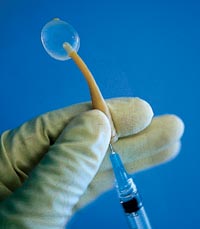Stabbed in the Chest
A helicopter ambulance service called saying they were bringing in an eighteen-year-old man who had been stabbed in the chest. The radio report from the frantic flight nurse painted a picture of a very seriously injured person. He was confused and had a weak pulse and a low blood pressure. We quickly prepared for his arrival: trauma team called, equipment readied, blood ordered up from the blood bank.
By the time they got him down from the rooftop helicopter pad and into the trauma bay, he was in his last gasps. All hands went to work at once. I sedated and paralyzed him so I could put a breathing tube in his windpipe. We could then get air into his lungs and provide him with oxygen. When it was clear that he had no pulse, a tech did chest compressions. The trauma surgeons put in large IV’s, through which he was given fluids and blood.
It soon was apparent that all of this was not enough so a thoracotomy was preformed. This is similar to what is done when someone has open-heart surgery but is, obviously, simplified and done as rapidly as possible. A cut is made between two ribs on the left side, all the way through the chest wall, into the chest cavity. A spreader is inserted into the cut and positioned between the ribs. The ribs are then spread open so the surgeon can get to the heart. If the source of the bleeding is identified, it can be sewn closed. The heart can actually be squeezed by hand, which is more effective in moving blood forward than the chest compressions done during CPR.
All of this was done quickly and successfully but was to no avail. His heart never started beating again and he was pronounced dead. When the decision was made to stop the resuscitation, a dramatic change took place in the feeling in the room. Immediately, all feverishly applied efforts to save a life just stopped. Rather than hollered commands and replies, voices were quiet and subdued. Rather than aggressive, heroic actions, activities moved to the mundane like cleaning up and preparing the body for the morgue.
Telling someone his or her loved-one is dead is the worst part of my job. It is bad enough if the person was old and had lived a full life. It is really hard to tell parents their son was murdered with a stab to the chest and at such a young age. Thank goodness I didn’t know at the time that his brother was the person who stabbed him, during an argument over a video game.



